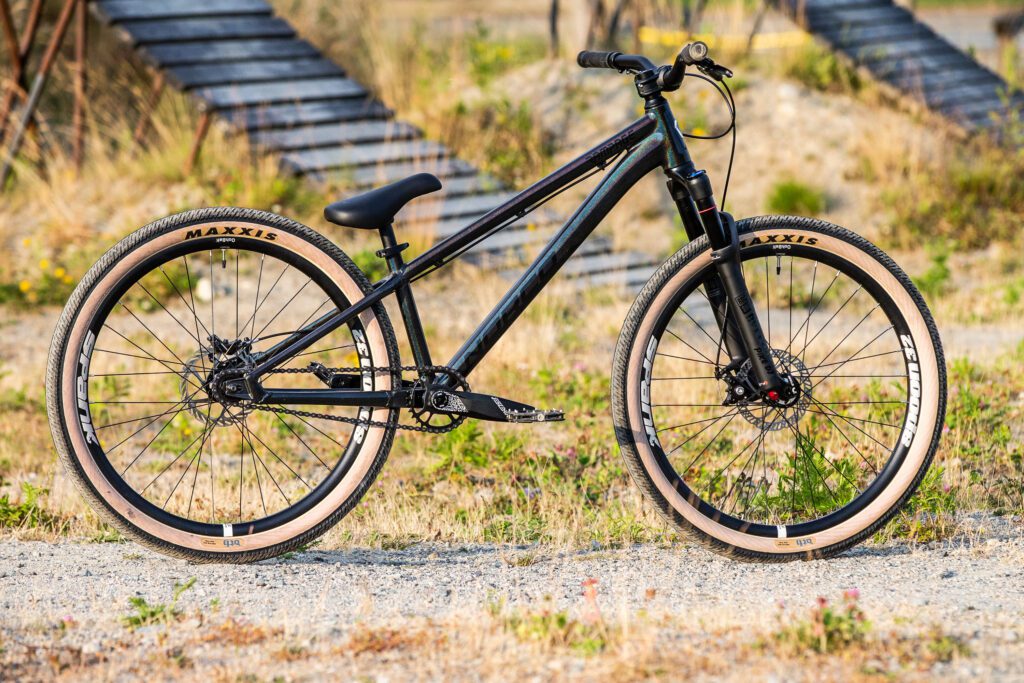


The allure of dirt jumpers lies in their urban prowess, their frames built to defy gravity on ramps and in skateparks. But what happens when you venture beyond the city limits, into the untamed expanses of trails?
The question of whether you can ride a dirt jumper on trails stirs curiosity among both dirt jump aficionados and trail enthusiasts.
An Unconventional Blend
Dirt jumpers are designed for acrobatic feats and quick bursts of energy, making them seem unlikely companions for trails that demand endurance and versatility.
However, the world of mountain biking thrives on innovation, and some riders have begun to blur the lines between these two distinct disciplines.
Navigating the Terrain
The success of riding a dirt jumper on trails hinges on understanding the bike’s limitations and the trail’s demands. While dirt jumpers lack the plush suspension of traditional trail bikes, their nimble handling could be advantageous on flowy tracks.
Yet, technical descents and rugged climbs might reveal the gaps in their armor.
Skill and Adaptation
Ultimately, the question transcends bike mechanics and terrain types. It’s about the rider’s adaptability and willingness to challenge conventions.
Riding a dirt jumper on trails is a testament to the spirit of experimentation, where riders test their skill and creativity to uncover a new facet of mountain biking.
In Search of Adventure
In this exploration of fusing urban innovation with natural landscapes, the answer to whether you can ride a dirt jumper on trails becomes a journey in itself.
It’s an invitation to step outside our comfort zones, redefine possibilities, and discover a hybrid experience that could revolutionize how we view mountain biking.
Related: How to make a dirt Jumper
Understanding Dirt Jumper Design: Strengths and Limitations
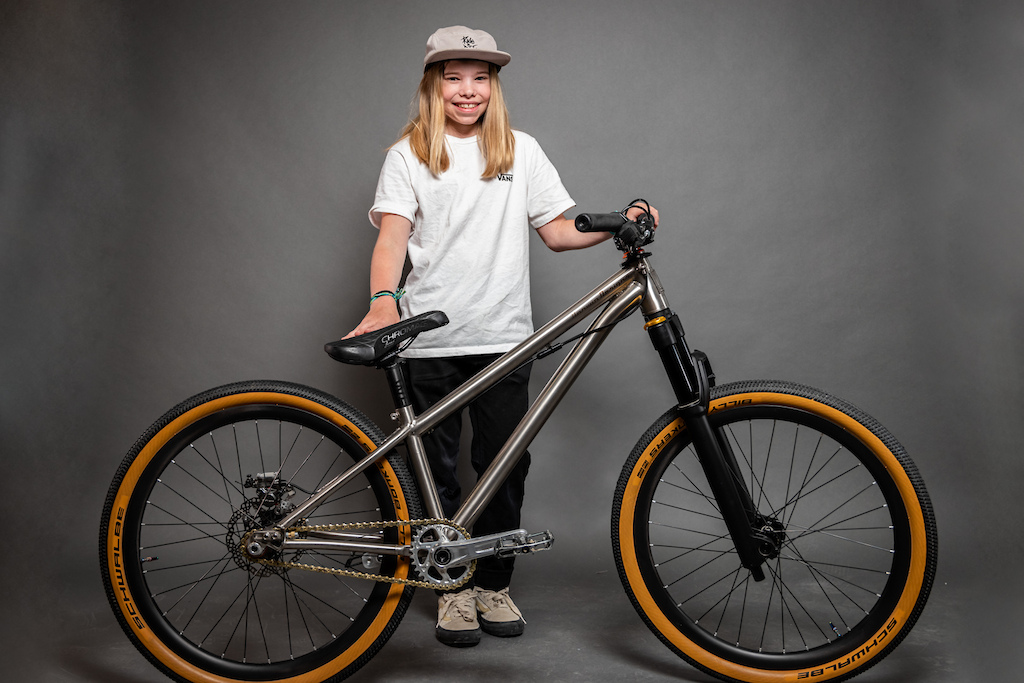


Dirt jumpers are purpose-built bikes designed primarily for the high-flying, acrobatic tricks performed in dirt jump parks and urban settings. Their design revolves around providing durability, maneuverability, and stability for tricks and jumps.
Read More : ” Is Biking Good For Knee Pain “
However, when it comes to trail riding, dirt jumpers face both strengths and limitations.
Strengths:
Durability:
Dirt jumpers are built tough to withstand the rigors of jumps, drops, and tricks. This robust construction can handle rough terrain encountered on trails, providing enhanced longevity.
Agility:
The compact frame and shorter wheelbase give dirt jumpers exceptional maneuverability. This agility can be advantageous on tight and technical trails, allowing for quick direction changes.
Responsive Handling:
Dirt jumpers offer quick and responsive handling, which can be beneficial on winding trails that demand frequent direction adjustments.
Limitations:
Suspension:
Dirt jumpers often have minimal suspension or a rigid fork, which may lead to a less comfortable ride on bumpy trails compared to trail-specific bikes with advanced suspension systems.
Gearing:
Dirt jumpers typically have single-speed or limited-gear setups, which might limit your speed and efficiency on longer or uphill trail sections.
Geometry:
The geometry that aids tricks and jumps can feel less stable at higher speeds, and the lack of a slack head angle could affect downhill control.
In summary, while dirt jumpers can handle trails to some extent, they are optimized for different purposes. Riders looking to primarily explore trails might find themselves limited by the bike’s lack of advanced suspension and gear range.
However, for those seeking a unique challenge and adapting their riding style, taking a dirt jumper on trails can offer an exciting and thrilling experience.
Dirt Jumpers and Trail Riding: An Unconventional Pairing



Dirt jumpers, with their origins in the world of freestyle BMX and urban trick riding, may seem like an unlikely choice for tackling trail riding.
Read More : ” Stumpjumper Alloy 2022 Review “
However, this unconventional pairing can offer both challenges and rewards for riders seeking a unique adventure on the trails.
Challenges:
Limited Suspension:
One of the key challenges of using a dirt jumper for trail riding is the limited suspension. Dirt jumpers often feature a rigid fork or minimal suspension travel, which can result in a less comfortable ride on rough and technical trails.
Gearing:
Dirt jumpers typically have single-speed or limited-gear setups, designed for short bursts of power during jumps and tricks. This can be a disadvantage on long climbs or varied terrains where a wider gear range is needed.
Geometry:
The geometry of a dirt jumper is optimized for aerial maneuvers and quick handling, which might feel less stable at higher speeds on descents or technical sections of the trail.
Rewards:
Agility:
Dirt jumpers are incredibly agile and responsive due to their compact frames and short wheelbases. This agility can be advantageous on tight and twisty trails, allowing riders to navigate through obstacles with precision.
Skill Development:
Riding a dirt jumper on trails can challenge riders to develop their technical skills and adapt their riding style. Learning to handle a bike designed for tricks in a trail environment can enhance overall riding capabilities.
Thrill and Fun:
The unconventional nature of using a dirt jumper for trail riding can add an element of excitement and novelty to your riding experience. The challenges you overcome and the tricks you can still incorporate can make for a unique adventure.
In conclusion, while dirt jumpers may not be the ideal choice for dedicated trail riding due to their design limitations, they can still provide an exhilarating and enjoyable experience for riders looking to push their boundaries and experiment with different terrains.
If you’re open to embracing the challenges and adapting your riding style, taking a dirt jumper on the trails can lead to unforgettable rides and personal growth as a cyclist.
Exploring the Limits: Can Dirt Jumpers Handle the Trail Terrain?
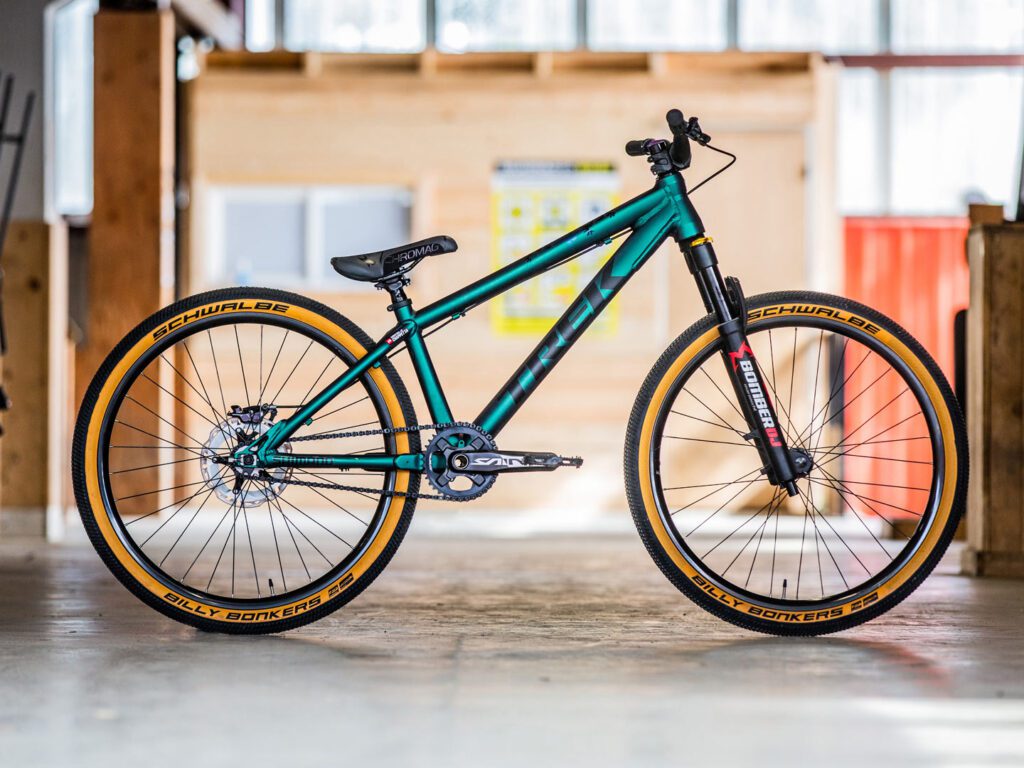


Dirt jumpers, renowned for their prowess in skate parks and urban landscapes, have ventured into the world of trail riding.
Read More : ” Does Biking Help Lose Belly Fat? “
This exploration raises the question: Can these agile and trick-oriented bikes handle the demands of trail terrain?
Design Features:
Rigid Frames:
Dirt jumpers typically feature sturdy, rigid frames designed for the shocks of jumps and tricks. While this robust build provides durability, it lacks the suspension needed to absorb the impact of rough trails.
Short Wheelbase:
A compact frame with a short wheelbase offers quick handling, making dirt jumpers nimble for tight turns and maneuvers. However, this agility might compromise stability on fast descents.
Challenges on Trails:
Limited Suspension:
Dirt jumpers often have minimal suspension, if any. This deficiency can result in a jarring ride on rocky trails, making long rides uncomfortable.
Gearing:
Many dirt jumpers have single-speed setups, limiting versatility on varying terrains. Climbing steep inclines or maintaining speed on flat stretches may pose challenges.
Geometry:
The geometry optimized for tricks may not translate well to trail riding. The bike’s posture, head angle, and wheelbase could affect stability during technical descents or climbs.
Trail-Worthy Traits:
Agility:
Dirt jumpers excel in agility, making them adept at navigating tight, twisty trails and technical sections.
Skill Development:
Riding a dirt jumper on trails hones technical skills, forcing riders to adapt to unconventional terrain.
Personal Challenge:
Riding a dirt jumper on trails offers a unique thrill and pushes riders beyond their comfort zones.
In summary, while dirt jumpers might not be tailored for extensive trail riding, their foray onto trails sparks curiosity. Their resilience, maneuverability, and the exhilaration of confronting new challenges make them intriguing choices for adventurous riders.
While not the optimal trail bike, a dirt jumper can elevate your riding experience, offering an unconventional twist to the world of trail riding.
Trail Selection: Matching Terrain and Bike Abilities
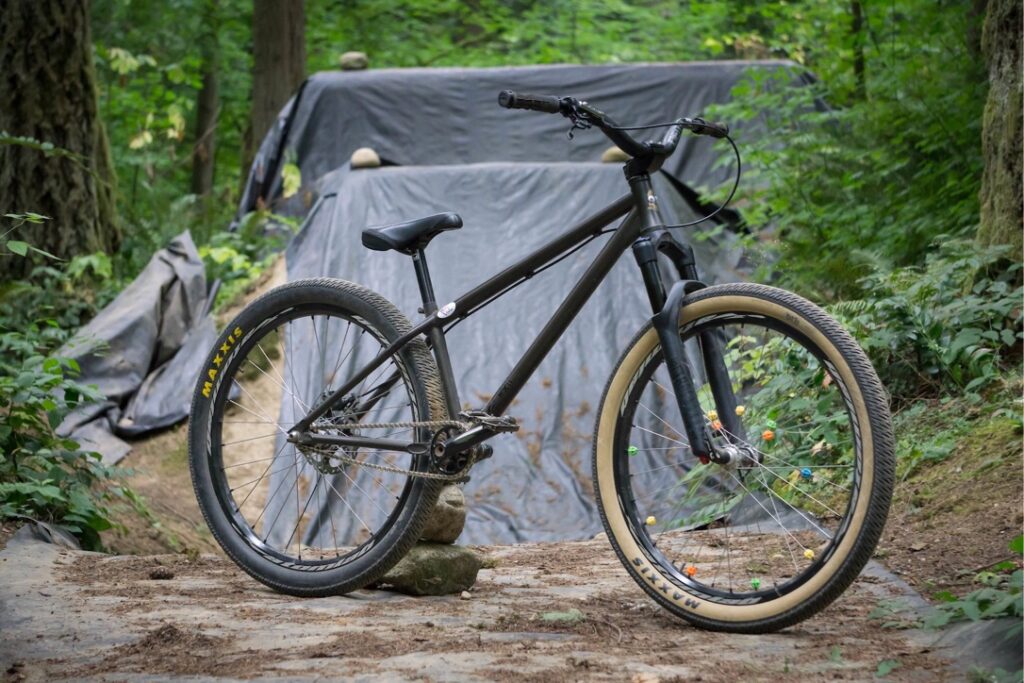


When considering taking a dirt jumper onto trails, the critical aspect is selecting the appropriate trails that align with the bike’s unique abilities.
Read More : ” Stumpjumper Comp Alloy Weight “
While dirt jumpers are not typically designed for extensive trail riding, strategic trail selection can enhance the experience.
Here’s how to make the right choice:
Trail Difficulty:
Choose trails that match your skill level and the capabilities of the dirt jumper. Start with easy to moderate trails that have minimal technical features and obstacles.
Smooth Terrain:
Opt for trails with smoother terrain to minimize the impact on the rigid frame of a dirt jumper. Avoid extremely rocky or root-laden trails that could lead to discomfort and potential damage.
Flow Trails:
Look for flow trails that offer a smoother ride, gradual turns, and berms. These trails complement the dirt jumper’s agility and provide an enjoyable experience without excessive stress on the bike.
Pump Tracks and Skills Parks:
Pump tracks and skills parks are ideal environments for dirt jumpers. These purpose-built areas allow you to explore the bike’s strengths in controlled settings.
Technical Challenges:
Gradually progress to more technical trails as you become familiar with the bike’s behavior on trails. Be cautious with challenging features like steep descents, rock gardens, and technical climbs.
Consideration for Others:
Keep in mind that dirt jumpers can handle differently from traditional trail bikes. Choose trails that are less crowded and inform fellow riders about your bike’s characteristics.
Skill Development:
Embrace the learning experience. Riding a dirt jumper on trails can improve your bike-handling skills and offer a fresh perspective on trail riding.
In essence, the key to a successful dirt jumper-trail marriage is selecting trails that complement the bike’s strengths and provide a positive riding experience.
By carefully choosing the right terrain, you can enjoy the thrill of taking a dirt jumper onto trails while minimizing discomfort and potential damage to the bike.
Skill and Technique: Adapting Riding Style for Trail Riding



Transitioning from dirt jumping to trail riding requires a shift in riding style and technique to maximize safety and enjoyment.
Here’s how to adapt your riding approach when taking a dirt jumper onto trails:
Body Positioning:
While dirt jumping emphasizes a more upright and controlled stance, trail riding demands a dynamic body position. Shift your weight forward for climbs, center your weight over the bike for balance, and shift back for descents to maintain stability.
Braking Technique:
Trail riding often involves varied terrain, including descents and technical sections. Master controlled braking techniques, using both front and rear brakes judiciously to maintain control and prevent skidding.
Line Choice:
Choose the smoothest lines to minimize impact on the bike and maximize efficiency. Aim for the path of least resistance, avoiding obstacles that can lead to jarring impacts.
Cornering Skills:
Dirt jumpers excel at quick turns and spins, but trail corners demand a broader, more controlled approach. Practice proper body positioning and wide arcs to maintain stability through corners.
Climbing Strategy:
Use seated climbing on longer ascents to conserve energy. Distribute your weight evenly between the wheels to maintain traction and prevent wheel spin.
Trail Awareness:
Constantly scan the trail ahead for obstacles, technical features, and changes in terrain. This awareness will help you anticipate challenges and adjust your riding accordingly.
Speed Management:
Trail riding often involves varying speeds. Use controlled acceleration and braking to maintain a steady pace, especially on descents where excessive speed can lead to loss of control.
Riding Etiquette:
Be mindful of other trail users. Slow down and yield the trail to hikers and other bikers when necessary. Respect trail rules and guidelines to ensure a positive experience for everyone.
Progressive Riding:
Start with easier trails and gradually progress to more technical ones as you gain confidence and adapt your riding style to the trail environment.
Patience and Adaptability:
Remember that transitioning to trail riding with a dirt jumper is a learning process. Be patient with yourself as you adapt your skills and technique to different terrain.
By adjusting your riding style and technique to match the demands of trail riding, you can ensure a safer and more enjoyable experience when taking a dirt jumper onto trails. Embrace the opportunity to expand your skill set and explore new riding challenges.
Rider Stories: Adventures and Challenges of Taking a Dirt Jumper Offroad
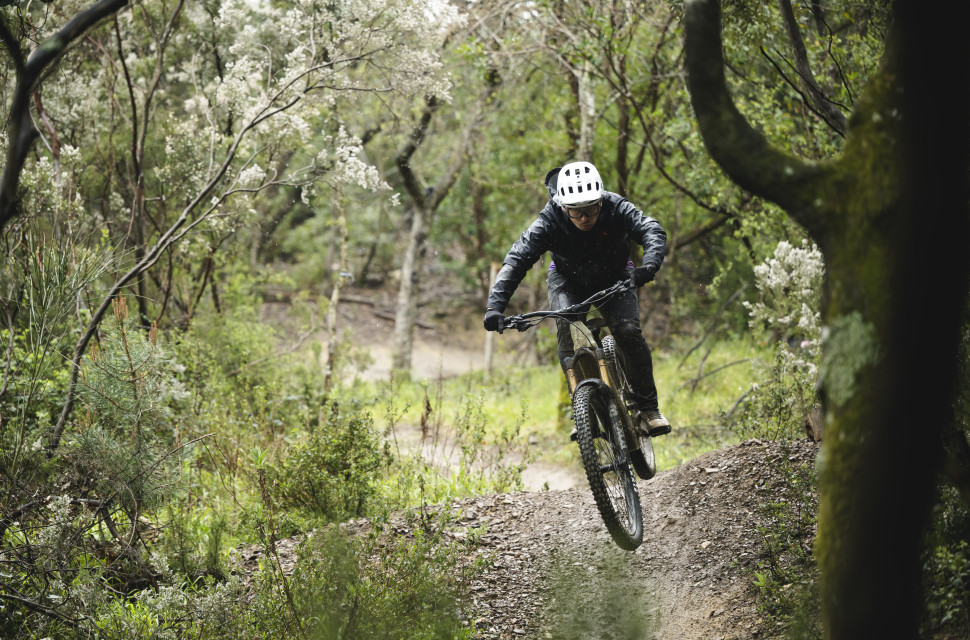


Dirt jumpers are known for their agility and performance in the air, but what happens when riders take them off the purpose-built dirt jumps and onto the unpredictable terrain of trails?
This section explores the real-life experiences, adventures, and challenges of riders who have dared to bring their dirt jumpers offroad:
Novelty and Excitement:
Many riders are drawn to the idea of using their dirt jumpers for trail riding due to the thrill of exploring new terrains and pushing their riding skills to the limit.
Technical Challenges:
Riders quickly realize that trail riding presents a whole new set of challenges compared to dirt jumping. Technical descents, roots, rocks, and steep climbs can test their bike handling skills and force them to adapt their riding style.
Adaptation and Learning Curve:
Dirt jumpers are built for aerial maneuvers and precision, so riders need to adapt their techniques for sustained riding on trails. This adaptation often comes with a learning curve as riders master braking, cornering, and negotiating obstacles in a new way.
Versatility Discovery:
Some riders find that their dirt jumpers are surprisingly versatile on trails, handling jumps, drops, and technical features with finesse. They enjoy the bike’s nimbleness and responsiveness on varied terrain.
Limitations Revealed:
While dirt jumpers excel in the air and on jumps, they can be less forgiving on rough trails. Riders may feel the lack of suspension and comfort on longer rides or when tackling demanding technical sections.
Finding the Right Trails:
Riders share their experiences of finding trails that suit their dirt jumpers’ capabilities. Flowy, jump-filled trails offer the best playground for showcasing the bike’s strengths.
Building Skills:
Trail riding forces riders to build endurance, develop proper technique, and refine their bike control. The process of adapting their skills can be challenging but ultimately rewarding.
Community and Sharing:
Riders connect with others who are exploring the same adventure of taking dirt jumpers onto trails. They share tips, stories, and experiences, fostering a sense of community among like-minded riders.
Personal Growth:
The journey from dirt jumps to trails offers a chance for personal growth and skill development. Riders experience the satisfaction of conquering new challenges and expanding their riding horizons.
Through the stories of riders who have ventured off the dirt jumps and onto trails, we gain insights into the unique experiences, challenges, and rewards of taking a dirt jumper into the world of trail riding.
Each rider’s journey is a testament to the adaptability of both the rider and the bike, and a reminder that the thrill of exploration is at the heart of mountain biking.
The Future of Mountain Biking: Pushing Boundaries and Blurring Categories



The world of mountain biking is in a state of continuous evolution, and as we look toward the future, it’s clear that exciting changes and innovations are on the horizon.
This section delves into the trends and developments that are shaping the future of mountain biking, pushing boundaries, and blurring the traditional categories:
Technological Advancements:
Advances in technology are revolutionizing mountain biking. From smart suspension systems to integrated digital displays, bikes are becoming more sophisticated, enhancing the riding experience and providing valuable data to riders.
E-Mountain Bikes (E-MTBs):
The rise of electric-assist mountain bikes is altering the landscape of the sport. E-MTBs are extending the range and accessibility of trails, allowing riders to tackle longer distances and more challenging terrain.
Sustainability and Eco-Friendly Practices:
As environmental concerns grow, the mountain biking community is placing a greater emphasis on sustainable practices. Eco-friendly trail building, responsible riding, and advocacy for conservation are becoming integral parts of the sport.
Trail Diversity:
Mountain biking is no longer confined to specific trail types. Riders are exploring urban environments, gravel roads, and mixed-terrain routes, blurring the lines between disciplines and expanding the definition of what constitutes a mountain biking adventure.
Inclusivity and Diversity:
Efforts to make mountain biking more inclusive and diverse are gaining momentum. Initiatives to welcome riders of all backgrounds, genders, and abilities are reshaping the sport’s culture and community.
Skills and Education:
As riders seek to tackle more challenging terrain, the importance of proper skills and education is growing. Riding clinics, online resources, and coaching programs are helping riders build the techniques needed to safely conquer technical features.
Exploration and Adventure:
The spirit of exploration remains a driving force in mountain biking. Bikepacking, backcountry adventures, and exploration of remote trails are inspiring riders to go beyond their comfort zones and embark on epic journeys.
Competitive Evolution:
Competitive mountain biking is evolving, with new formats such as Enduro gaining popularity. These formats emphasize versatility, endurance, and skills across various trail types, showcasing riders’ all-around abilities.
Collaboration and Community:
Collaboration among riders, trail builders, and advocacy groups is fostering a sense of community and shared responsibility for the sport’s future. Collective efforts are shaping the landscape, ensuring sustainable growth and access to trails.
Global Connectivity:
Digital platforms are connecting mountain bikers from around the world, facilitating the exchange of information, route recommendations, and experiences. Riders can now learn from and connect with fellow enthusiasts across borders.
As the future of mountain biking unfolds, it’s clear that the sport is poised for exciting transformations. The blurring of traditional categories, the integration of technology, and the emphasis on sustainability and inclusivity are reshaping the landscape.
With these trends driving the way, the future promises a vibrant and dynamic era for mountain biking enthusiasts.
Conclusion
Can You Ride a Dirt Jumper on Trails? After exploring the intricacies of dirt jumpers and their compatibility with trail riding, it’s evident that the answer isn’t a straightforward yes or no.
While dirt jumpers are designed for aerial tricks and stunts on dirt jumps and pump tracks, they can indeed be ridden on trails, provided certain considerations are taken into account.
Dirt jumpers’ sturdy build, responsive handling, and maneuverability make them capable of tackling trail terrain to some extent. However, their lack of suspension and specific design characteristics might limit their performance and comfort on rough and technical trails.
Ultimately, the decision to ride a dirt jumper on trails depends on your riding style, skill level, and the trails you intend to conquer. If you’re seeking a versatile bike that excels in both aerial maneuvers and trail riding, a trail-oriented mountain bike might be a better choice.
In the world of mountain biking, experimentation and pushing boundaries are part of the thrill. While dirt jumpers might not be the ideal choice for extensive trail riding, their adaptability showcases the dynamic nature of the sport.
So, can you ride a dirt jumper on trails? Yes, you can, but keep in mind that it’s all about finding the right balance between the bike’s capabilities and your riding preferences.
FAQ’s
Can a dirt jumper be used as a mountain bike?
Yes, a dirt jumper can be used as a mountain bike to some extent. However, its design and lack of suspension might limit its performance on technical trails compared to dedicated mountain bikes.
Can trail dirt bikes do jumps?
Yes, trail dirt bikes are designed to handle jumps and rough terrain. Their geometry and suspension allow for controlled take-offs and landings, making them suitable for jumping.
Are dirt jumpers good for long rides?
Dirt jumpers are not ideal for long rides due to their specialized design for jumps and tricks. Their geometry and components are better suited for short bursts of intense riding.
Can you do jumps on a trail bike?
Yes, trail bikes are designed to handle a variety of terrain, including jumps. They offer a balance between agility and stability, making them suitable for jumping while still being capable on trails.
Should I get a dirt jumper or BMX?
Choose a dirt jumper if you’re looking for a versatile bike that can handle trails and jumps. Opt for a BMX if you’re focused on tricks and park riding.



Welcome to Bikegenics, where passion meets performance! We are a leading online destination for all things related to mountain biking, dedicated to providing you with top-notch gear, expert advice, and an immersive community to fuel your two-wheeled adventures. With a commitment to excellence and a deep love for the sport, we strive to elevate your biking experience to new heights.
